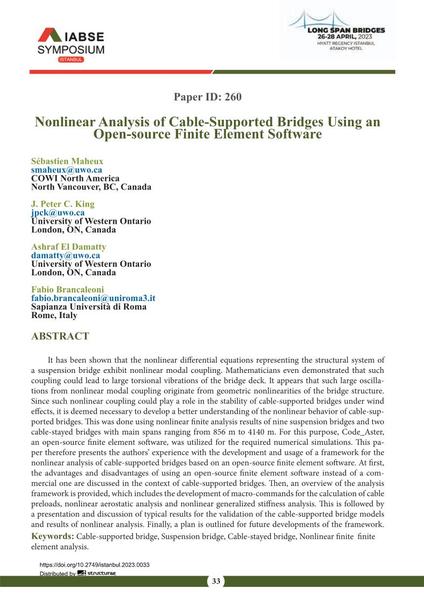Nonlinear Analysis of Cable-Supported Bridges Using an Open-source Finite Element Software

|
|
|||||||||||
Bibliografische Angaben
| Autor(en): |
Sébastien Maheux
(COWI North America, North Vancouver, BC, Canada)
J. Peter C. King (University of Western Ontario London, ON, Canada) Ashraf El Damatty (University of Western Ontario London, ON, Canada) Fabio Brancaleoni (Sapianza Università di Roma Rome, Italy) |
||||
|---|---|---|---|---|---|
| Medium: | Tagungsbeitrag | ||||
| Sprache(n): | Englisch | ||||
| Tagung: | IABSE Symposium: Long Span Bridges, Istanbul, Turkey, 26-28 April 2023 | ||||
| Veröffentlicht in: | IABSE Symposium Istanbul 2023 | ||||
|
|||||
| Seite(n): | 33-40 | ||||
| Anzahl der Seiten (im PDF): | 8 | ||||
| Jahr: | 2023 | ||||
| DOI: | 10.2749/istanbul.2023.0033 | ||||
| Abstrakt: |
It has been shown that the nonlinear differential equations representing the structural system of a suspension bridge exhibit nonlinear modal coupling. Mathematicians even demonstrated that such coupling could lead to large torsional vibrations of the bridge deck. It appears that such large oscillations from nonlinear modal coupling originate from geometric nonlinearities of the bridge structure. Since such nonlinear coupling could play a role in the stability of cable-supported bridges under wind effects, it is deemed necessary to develop a better understanding of the nonlinear behavior of cable-supported bridges. This was done using nonlinear finite analysis results of nine suspension bridges and two cable-stayed bridges with main spans ranging from 856 m to 4140 m. For this purpose, Code_Aster, an open-source finite element software, was utilized for the required numerical simulations. This paper therefore presents the authors’ experience with the development and usage of a framework for the nonlinear analysis of cable-supported bridges based on an open-source finite element software. At first, the advantages and disadvantages of using an open-source finite element software instead of a commercial one are discussed in the context of cable-supported bridges. Then, an overview of the analysis framework is provided, which includes the development of macro-commands for the calculation of cable preloads, nonlinear aerostatic analysis and nonlinear generalized stiffness analysis. This is followed by a presentation and discussion of typical results for the validation of the cable-supported bridge models and results of nonlinear analysis. Finally, a plan is outlined for future developments of the framework. |
||||
| Stichwörter: |
Schrägseilbrücke Hängebrücke
|
||||

